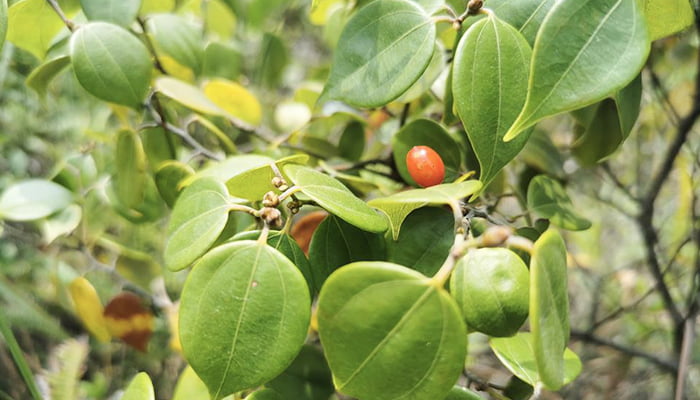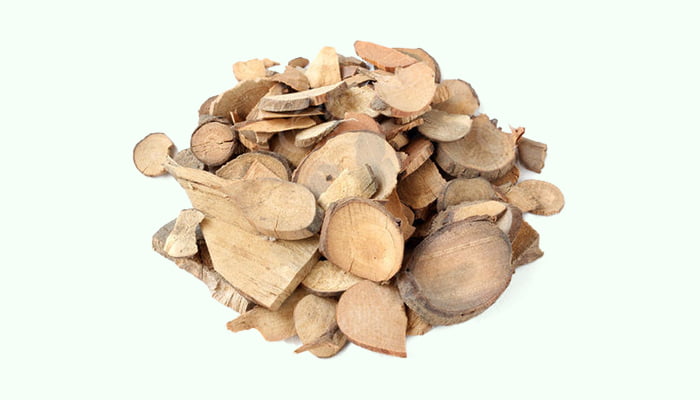What Is Wu Yao
Wu Yao commonly known as Radix Linderae is the dried and tuberous root of Lindera aggregata (Sims) Kosterm., which is an evergreen small tree or shrub belonging to the family Lauraceae. It is a relatively practical and common Chinese herbal medicine, which first appeared in <Ben Cao Shi Yi> (Supplements to Newly Revised Materia Medica) around 739 AD.
There are approximately 94 species of Lindera, which are widely distributed across tropical, subtropical, and temperate regions of Asia and the central-western parts of North America. Only a small number of species are found in the northeastern region of Australia. Most of these species contain abundant fats that can be used for making soap and lubricating oil. Only a few species are edible and medicinal, such as Lindera aggregata (Sims) Kosterm.
L. aggregata prefer subtropical climates and exhibit strong adaptability. They are well-suited for cultivation in areas with abundant sunlight and well-drained, fertile, acidic soils. They often grow in sunny slopes, valleys, or sparse forests at an altitude of 300-600 meters. They are distributed in central and southern China, as well as in Japan, Vietnam, and the Philippines.

L. aggregata can be gathered in any season. People gather their roots, remove impurities and rootlets, wash them with water, cut them into slices, dry them in the sun, and make them into Chinese herbal medicines.
Wu Yao contains pinostrobinchalcone, pinocembrin, pinostrobin, cirsimaritin, norboldine, norisoboldine, laurotetanine, linderaline, boldine, isoboldine, norjuziphine, argemexirine, reticuline, protosinomenine, hernangerine, actinodaphnine, lindoldhamine, costaricine, salutaridine, northalifoline, thalifoline, secoboldine, yuzirine, linderaggrine A~B, linderine A, pallidine, lindenene, lindenenol, linderene acetate, lindestrenolide, hydroxylinderstrenolide, isogermafurenolide, parvigemone, linderalactone, lindestrene, isolinderalactone, neolinderalactone, linderaggredin A~D, linderagalactone A~E, atractylenolide III, linderin A~B, linderanlide A~F, linderanine A~C, linderolide A~V, pseudneolinderanec, linderaggrenolide A~N, linderalide A~D, linderanoid A~O, aggreganoid A~F, β-sitosterol, α -cadinol, linderone, lucidone, ethyllucidone, cinnamic acid, and volatile oils.
Generally, the tender Wu Yao with a yellow-brown cross-section, a strong aroma, and high starch content are preferred. Traditionally, Wu Yao produced in Tiantai County, Taizhou City, Zhejiang Province, is considered Daodi medicinal material. Thus, it is also called Tai Wu or Tian Tai Wu Yao.
According to the Chinese Pharmacopoeia, the medicinal nature of Wu Yao is relatively warm, with a pungent taste. It has a certain therapeutic effect on the pathological changes of the lung, spleen, kidney, and bladder meridians.
In traditional Chinese medicine, it is often used to promote qi circulation and relieve pain, warm the kidney and dispel cold, and treat chest and abdominal pain, hernia pain, and dysmenorrhea caused by qi stagnation due to congealing cold, frequent urination, enuresis, irregular menstruation, hypomenorrhea, menostaxis, uterine prolapse, postpartum abdominal pain, poor appetite, superficial gastritis, gastric ulcers, colitis, intestinal spasms in children, periumbilical colic due to cold, chronic prostatitis, chronic epididymitis, stress urinary incontinence, chronic liver injury, sciatica, rheumatoid arthritis, traumatic injuries, kidney water retention, hydrocephalus, cerebral infarction, epidemic hemorrhagic fever in polyuria period, and primary splenic flexure syndrome.
There are more than 50 kinds of traditional Chinese medicine prescriptions containing it, such as Wu Yao Tang, Tian Tai Wu Yao San, and Suo Quan Wan.
Benefits
- Anti-inflammation, inhibiting xylene-induced ear swelling and carrageenan-induced paw swelling in mice [1].
- Pain relief, reduces the number of times mice lick their paws on a hot plate and the number of times mice exhibit writhing induced by acetic acid [1].
- Promoting qi circulation and dispelling cold, treating chest and abdominal pain, hernia pain, and dysmenorrhea caused by qi stagnation due to congealing cold.
- Arranging qi and treating chest stuffiness, wheezing, and coughing caused by upward perversion of cold-qi.
- Warming the kidney and dispelling cold, treating frequent urination and enuresis in children caused by insufficiency of the kidney yang or deficiency cold in the bladder.
- Its water extract slows down the progression of diabetic nephropathy in a genetic diabetes mouse model and improves renal function [2].
- Its extracts attenuated adenine-induced chronic kidney disease by modulating the metabolic profiles and TGF-β/Smad signaling pathway [3].
- Its ethanol extract alleviated diet-induced hyperlipidemia in rats by modulating the gut microbiota to regulate bile acid metabolism [4].
- Its ethanolic extract alleviated the oxidative stress and acute liver inflammation induced by alcohol through the SIRT1/Nrf2/NF-κB pathway and modulated the disturbance of gut microbiota induced by alcohol intake [5].
- Its extract can regulate the IL-6 signaling pathway to modulate the balance of Th17 and Treg cells, thus attenuating dextran sulfate sodium-induced colitis in mice [6].
- It can inhibit LPS-induced lung inflammation and alleviate lung injury in acute respiratory distress syndrome (ARDS) mice. The mechanism may be related to the inhibition of the activation of the p38 mitogen-activated protein kinase/ERK (p38MAPK/ERK) signaling pathway [7].
- Norisoboldine has been demonstrated to improve collagen- or adjuvant-induced arthritis in mice. It was indeed able to suppress osteoclast differentiation by targeting at the early stage and inhibit osteoclastic-resorbing function via down-regulating the expressions of the bone matrix-degrading enzymes cathepsin K and MMP-9 [8].
- Isolinderalactone can inhibit the growth of U-87 human glioblastoma cells and the proliferation of A549 human non-small cell lung cancer cells, inducing apoptosis [9, 10]. Furthermore, it can induce apoptosis in human ovarian cancer cells by increasing the production of mitochondrial superoxide (mtSO), decreasing the expression of superoxide dismutase 2, and interfering with the signal transducer and activator of the transcription 3-mediated signaling pathway [11].
- Research has found that it can alleviate cell damage caused by Aβ toxicity and inhibit the expression of iNOS and COX-2 by suppressing the p38 MAPK pathway, ultimately reducing the production of NO. Additionally, it can inhibit microgliosis and synaptic loss, thereby preventing memory impairment. It may serve as a potential candidate for treating various neurodegenerative diseases [12].
Combinations
- It can be used in combination with Xiang Fu (Rhizoma Cyperi), Chuan Lian Zi (Fructus Meliae Toosendan), Mu Xiang (Radix Aucklandiae), etc. to treat chest and abdominal pain caused by qi stagnation.
- It can be used in combination with Mu Xiang (Radix Aucklandiae), Qing Pi (Citri Reticulatae Pericarpium Viride), and E Zhu (Rhizoma Curcumae), etc., to treat abdominal distention and pain caused by qi stagnation.
- It can be used in combination with Xiao Hui Xiang (Fructus Foeniculi), Qing Pi (Citri Reticulatae Pericarpium Viride), Gao Liang Jiang (Rhizoma Alpiniae Officinarum), etc. to treat periumbilical colic due to cold.
- It can be used in combination with Dang Gui (Radix Angelicae Sinensis), Wu Zhu Yu (Evodiae Fructus), Xiang Fu (Rhizoma Cyperi), etc. to treat dysmenorrhea caused by caused by qi stagnation due to congealing cold.
- It can be used in combination with Ma Huang (Herba Ephedrae), Chen Xiang (Aquilariae Lignum Resinatum), Xiao Hui Xiang (Fructus Foeniculi), etc. to treat chest stuffiness, wheezing, and coughing caused by upward perversion of cold-qi.
- It can be used in combination with Yi Zhi Ren (Sharpleaf Galangal Fruit), Shan Yao (Rhizoma Dioscoreae), etc. to treat frequent urination and enuresis in children caused by insufficiency of the kidney yang or deficiency cold in the bladder.
Side Effects
- Toxicological studies have confirmed that the leaves of L. aggregata are non-toxic and have no genetic toxicity. It is safe to take it for a long time.
- Short-term feeding of L. aggregata to rats and mice did not cause acute poisoning, nor did it cause mutations in genes, chromosomes, and cells, but high doses of it caused relatively non-pathological enlargement of the animal liver and had no significant effect on various indicators of liver function and histopathological observation.
- The maximum non-effective dose of L. aggregata is 5.0 g/kg of body weight [13].
Precautions and Warnings
- The dosage of Wu Yao should be controlled between 5-10g.
- It can be made into decoctions, pills, or powdered forms for external application.
- People who are allergic to Wu Yao should not take it.
- Patients with qi deficiency or internal heat should not take it.
- Pregnant women and individuals with weakened constitutions should avoid taking it.
- Children, breastfeeding women, and elderly patients should take it under the guidance of a doctor.
